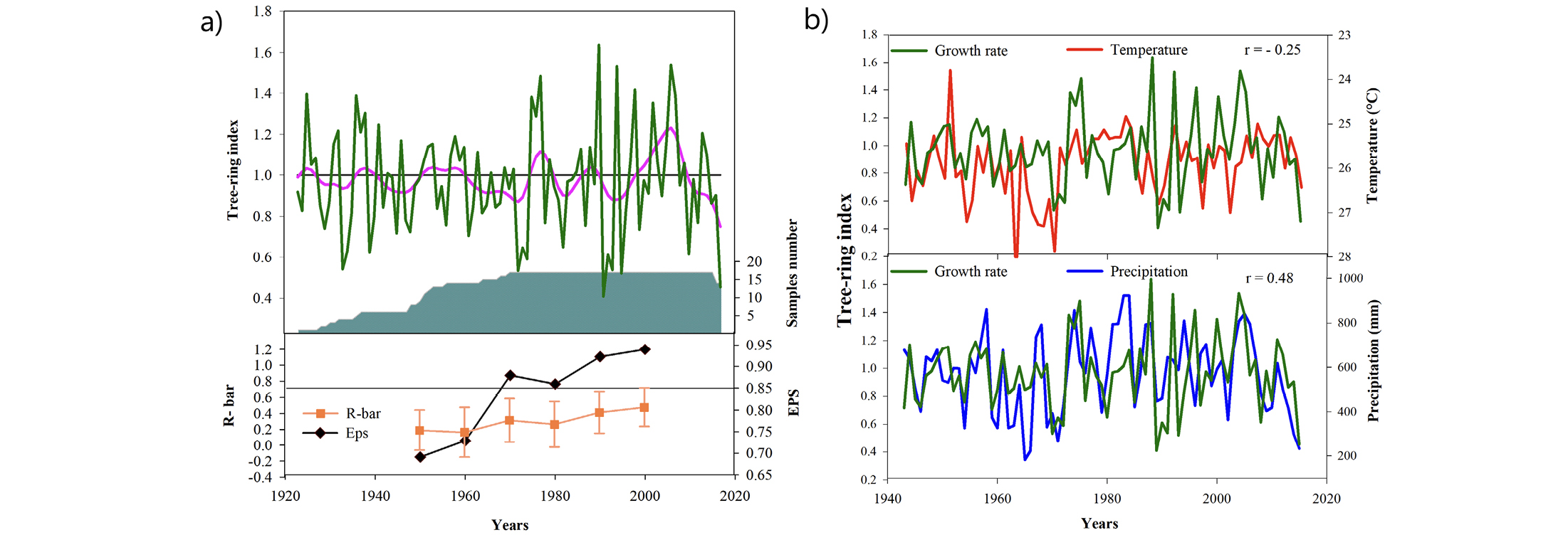- Home
- Publications
- PAGES Magazine
- Dendrochronological Potential of Tarara Colorada (Platymiscium Ulei Harms) In Tropical Dry Forests of Bolivia
Dendrochronological potential of Tarara colorada (Platymiscium ulei Harms) in tropical dry forests of Bolivia
Mónica Vicente
Past Global Changes Magazine
31(1)
37
2023
Bolivian engineer Mónica Vicente visited the dendrochronology laboratory at IANIGLA-CONICET in Mendoza , Argentina, as part of the PAGES-IAI International Mobility Research Fellowship Program. During her stay from March to May 2022 she worked with tree rings and performed growth measurements in relation to the climate of the sampling zone.
Bolivia has the largest proportion of tropical dry forests in South America. However, there is strong pressure on forest areas due to anthropogenic activity. The highest deforestation rates are concentrated in the lowlands where most of the tropical dry forests are located. Therefore, it is essential to use paleoproxies to understand climatic variation over the last centuries in this region.
Dendrochronology is one of the most common tools used to generate information and reconstruct past climatic variations. In this sense, tree-growth rings, besides providing paleoclimate information, also allow us to understand the growth ecology of new species of great value, such as Platymiscium ulei.
The objective of this project was to study the potential of P. ulei in dendrochronology in tropical dry forests of Bolivia. Samples of P. ulei were taken in the Mercedes Forest management area, in the municipality of Concepción, department of Santa Cruz, Bolivia. The area has a mean annual temperature of 25.4°C and 1150 mm of annual precipitation with marked seasonal droughts throughout the year.
After cross-sections, samples of tree trunks were processed, and the growth rings were dated and measured following standard methods in dendrochronology. The manual dating was performed with the COFECHA program to verify the individual quality of each measurement by detecting and correcting possible dating errors (Holmes 1983). Thereafter, all the samples were standardized with the ARSTAN program (Cook and Holmes 1999).
Chronology
The tree-ring chronology corresponds to the period 1923–2015 CE (17 samples). The chronology is replicated by more than 10 trees from 1950 CE, and in 65 years has an autocorrelation of 0.50 indicating a common sign of growth and a mean sensitivity of 0.41, indicating the interannual variability in the width of the rings. Likewise, the chronology has an R-bar (running series of average correlations) of 0.30, which indicates the common growth signal over a period of time, and an EPS (expressed population signal) of 0.85 (Fig. 1a).
EPS is an indicator of the population signal between a given chronology and a hypothetical chronology that has been replicated infinitely for a common time interval, and increases with more trees being incorporated (Wigley et al. 1984). Theoretically, EPS values equal to or greater than 0.85 indicate that the number of samples in the timeline is adequate, and capture an adequate percentage of the signal (Briffa 1999).
Climate-growth relationship
The tree-ring chronology starts at 1923 CE and climatological data are only available from 1943 CE onwards. The correlation of growth of P. ulei trees with precipitation during the wet season (October–March) is positive (r= 0.48; p<0.005) from 1943–2015 CE (Fig. 1b). The mean annual temperature for the same period has an inverse, but significant, correlation with growth rate (r=-0.25; p<0.005). The latter is explained by the higher temperatures that increase evapotranspiration, intensifying water deficit, and reducing radial growth (López and Villalba 2016).
The presence of growth rings in trees with annual periodicity is imperative for dendrochronological studies in tropical regions. In this sense, P. ulei trees in the Mercedes Forest present distinguishable rings with a similar growth pattern. Therefore, dendrochronological analysis can contribute to a better understanding of regional climate variability and its impact on the fragile ecosystems from which this species originates. The trees of this species capture a significant variation in the dominant climatic conditions of the area, which constitutes a premise for studies with dendroclimatic applications and, in turn, answers paleoclimatological and paleoecological questions prioritized by the paleoscientific community.
affiliation
Faculty of Agricultural Sciences, Gabriel René Moreno Autonomous University, Santa Cruz de la Sierra, Bolivia
contact
Mónica Vicente: monicavicente uagrm.edu.bo (monicavicente[at]uagrm[dot]edu[dot]bo)
uagrm.edu.bo (monicavicente[at]uagrm[dot]edu[dot]bo)
references
Briffa KR (1999) In: von Storch H, Navarra, A (Eds) Analysis of Climate Variability. Springer, 77-94
Holmes RL (1983) Tree-Ring Bull 43: 69-78
López L, Villalba R (2016) Dendrochronologia 40: 85-92
Wigley TML et al. (1984) J Appl Meteorol Climatol 23: 201-213
